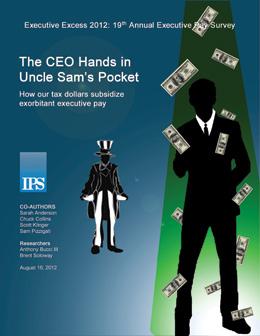 Nationwide, budget cuts have axed 627,000 public service jobs just since June 2009. Schools, health clinics, fire stations, parks, and recreation facilities—virtually no public service has gone unsqueezed. Tax dollars haven’t seemed this scarce in generations.
Nationwide, budget cuts have axed 627,000 public service jobs just since June 2009. Schools, health clinics, fire stations, parks, and recreation facilities—virtually no public service has gone unsqueezed. Tax dollars haven’t seemed this scarce in generations.
Yet tens of billions of these scarce tax dollars are getting diverted. These tax dollars are flowing from average Americans who depend on public services to the kingpins of America’s private sector. They’re subsidizing, directly and indirectly, the mega-million paychecks that go to the top executives at our nation’s biggest banks and corporations.
Exorbitant CEO pay packages have, of course, been outraging Americans for quite some time now. Every new annual CEO pay report seems to bring a rash of predictably angry editorials and calls for reform. But little overall has changed. Wages for average Americans continue to stagnate. Pay for top executives continues to soar.
One key reason why: Our nation’s tax code has become a powerful enabler of bloated CEO pay. Some tax rules on the books today essentially encourage corporations to compensate their executives at unconscionably higher multiples of what their average workers are paid.
Other rules let executives who run major corporations routinely reduce their corporate tax bills. The fewer dollars these corporations pay in taxes, the more robust their eventual earnings and the higher the “performance-based” pay for the CEOs who produce them.
In effect, we’re rewarding corporate executives for gaming the tax system. Our tax code is helping the CEOs of our nation’s most prosperous corporations pick Uncle Sam’s pocket.
In this latest Institute for Policy Studies Executive Excess annual report, our 19th consecutive, we take a close look at the most lucrative tax incentives and subsidies behind bloated CEO pay and highlight those executives who have reaped the highest rewards from tax code provisions that actively encourage outrageously disproportionate executive pay.
We also identify the top executives who have benefited the most from what have become known as “the Bush tax cuts”—the reductions in federal income tax rates on top-bracket, capital gains, and dividend income enacted in 2001 and 2003.
Among our findings:
- Of last year’s 100 highest-paid U.S. corporate chief executives, 25 took home more in CEO pay than their companies paid in federal income taxes. Seven firms made the list in both 2011 and 2010.
- The CEOs of these 25 firms received $20.6 million in average total compensation last year. That’s a 24 percent increase over the average for last year’s list of 2010’s tax dodging executives.
- The four most direct tax subsidies for excessive executive pay cost taxpayers an estimated $14.4 billion per year—$46 for every American man, woman, and child. That amount could also cover the annual cost of hiring 211,732 elementary-school teachers or creating 241,593 clean-energy jobs.
- CEOs have benefited enormously from the Bush tax cuts for upper-income taxpayers. Last year, 57 CEOs saved more than $1 million on their personal income tax bills, thanks to these Bush-era cuts.
What can be done to end today’s incredibly gross pay divide between top executives and average workers? In this year’s Executive Excess, we once again survey a wide range of reform notions with a “scorecard” that notes those reforms that have already been enacted, those still pending before Congress, and those proposals not yet before Congress that we believe hold the most CEO pay-deflating promise.
Go to the campaign page: Executive Excess 2012 Campaign